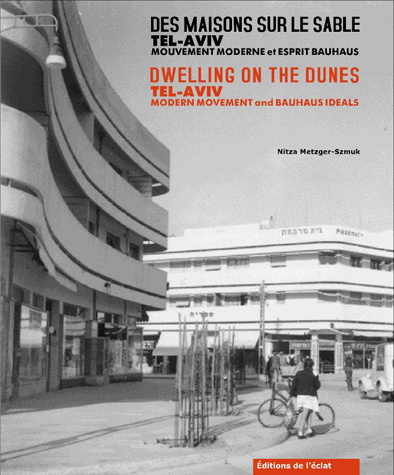Tel-Aviv est surgie des sables au début du vingtième siècle, et s’est développée de manière spectaculaire entre les deux guerres mondiales. Un très grand nombre d’architectes ayant étudié ou travaillé en Europe, à l’école du Bauhaus ou chez Le Corbusier, s’y installèrent à la fin des années 20 et y apportèrent les idées nouvelles de l’architecture européenne. Des formes de la Cité-jardin conçue par Sir Patrick Geddes, jusqu’aux lignes épurées des constructions d’une nouvelle génération d’architectes, la " Ville blanche" de Tel-Aviv est un musée à ciel ouvert du Mouvement Moderne et de l’esprit Bauhaus. Elle fait partie depuis juillet 2003 des sites choisis par l’UNESCO au titre du Patrimoine Mondial de l’Humanité.
À travers la présentation de plus de trois cents édifices et les biographies des plus importants architectes de l’époque, Des Maisons sur le sable retrace l’histoire de cette épopée architecturale et des hommes et femmes qui y prirent part. Nitza Metzger-Szmuk distingue différents ensembles de bâtiments, chacun ayant une relation particulière à l’espace public. Et c’est cette conscience aiguë d’une relation privilégiée entre le privé et le public qui fait la spécificité de l’architecture de Tel-Aviv, métropole méditerranéenne se renouvelant sans cesse au rythme de ses habitants et des vagues qui la baignent.
Dwelling on the Dunes
Tel-Aviv Modern Mouvement and Bauhaus Ideals
Tel Aviv, having sprung from the dunes at the beginning of the 20th century, would develop in a spectacular manner in the period between the two world wars. A very large number of architects who had studied and worked in Europe – some at the Bauhaus School or with Le Corbusier – established themselves in Tel Aviv in the late 1920s, bringing with them the innovative concepts of contemporary European architecture. Encompassing the surviving elements of Sir Patrick Geddes' garden city model as well as the distilled lines of buildings planned by a new generation of architects, Tel Aviv's "White City" is a veritable open-air museum of Modern Movement and Bauhaus ideals. In July 2003, it was designated by UNESCO a World Heritage Site.
Through its presentation of more than three hundred buildings and brief biographies of the major architects, Dwelling on the Dunes chronicles the history of this epic venture and of the men and women who were its protagonists. In her extensive survey, Nitza Metzger-Szmuk distinguishes different types of buildings, each relating in a specific way to the public space. This conscious distinction between the public and the private is one of the characteristic features of Modern Movement architecture in Tel Aviv – that Mediterranean metropolis, ever renewing itself along with the flux of its citizens and of the tides that wash its shores.
Nitza Metzger-Szmuk est née à Tel-Aviv en 1945. Elle a étudié l’architecture à l’Université de Florence (Italie). Entre 1975 et 1989 elle a travaillé à la restauration des bâtiments anciens en Toscane, où elle a établi un relevé des églises romanes pour la Direction des Monuments historiques. De retour en Israël en 1989, elle a mené alors une recherche sur le Mouvement Moderne à Tel-Aviv à l’initiative de la Mairie et de la Fondation Tel-Aviv. Elle a créé le service municipal de conservation et de restauration du bâtiment qu’elle a dirigé pendant douze ans. En 2002, elle a préparé et rédigé le dossier en vue de la nomination de la " Ville blanche" de Tel-Aviv au Patrimoine Mondial de l’Humanité. Nitza Metzger-Szmuk vit et travaille à Tel-Aviv, et enseigne les techniques de restauration des monuments à la Faculté d’Architecture du Technion de Haïfa.
Nitza Metzger-Szmuk was born in Tel Aviv in 1945. She studied architecture at the University of Florence, Italy, and between 1975 and 1989 worked on the restoration of buildings in Tuscany and conducted there a survey of Romanesque churches for the Historic Monuments Authority in Florence. Back in Israel in 1989, she began researching the Modern Movement in Tel Aviv within the framework of a programme initiated by the Municipality and the Tel Aviv Foundation. Having established the Conservation Team of the City Planning Department, she served as its head for twelve years. In 2002 she prepared and authored the dossier nominating the " White City" of Tel Aviv for the World Heritage List. Nitza Metzger-Szmuk lives and works in Tel Aviv and teaches building conservation at the Haifa Technion's Faculty of Architecture.


